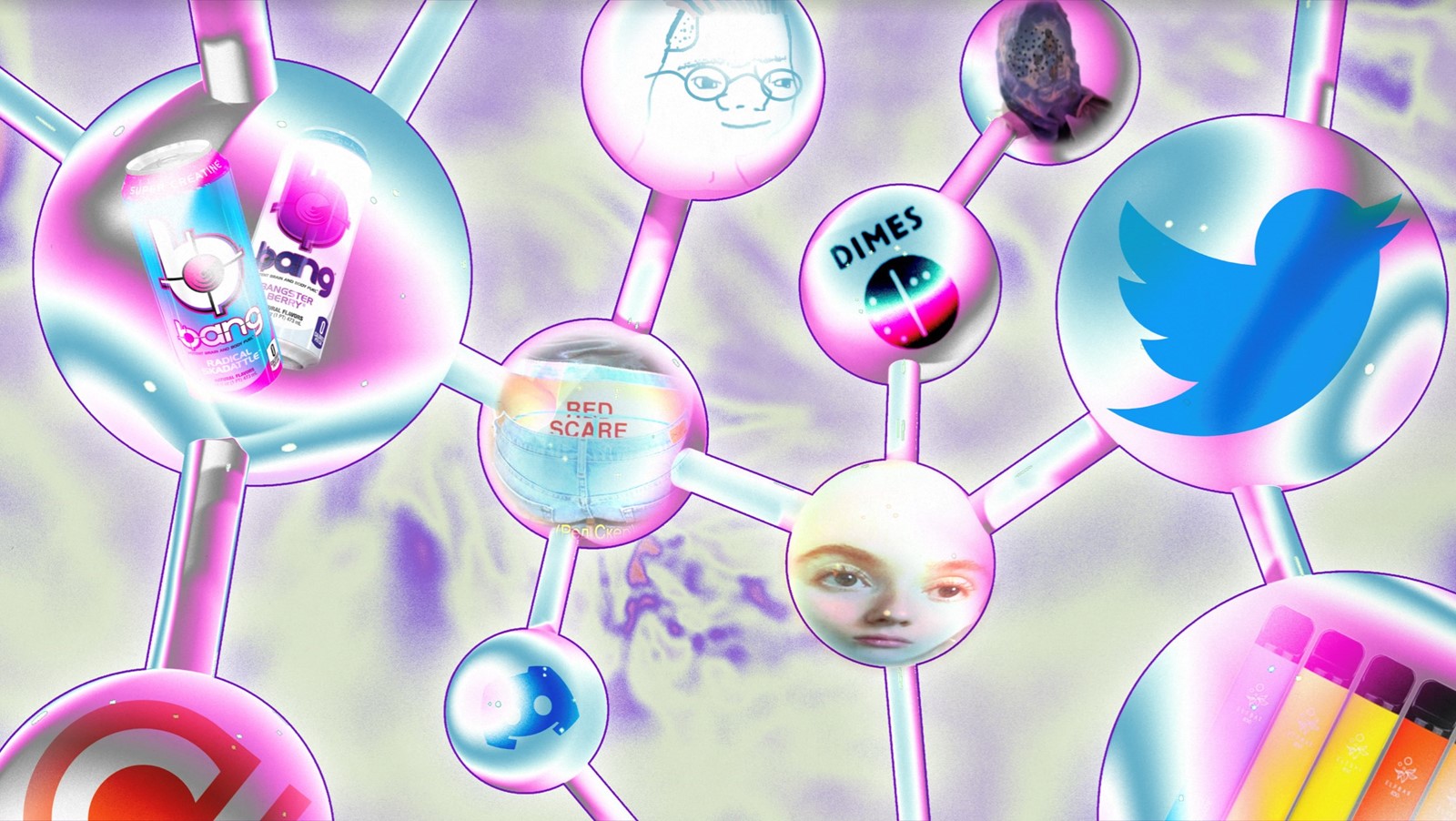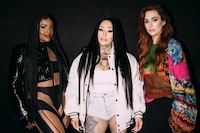There’s been a wave of writers lamenting the end of pop culture, the rise of bad content, and the relentless cycle of microtrends. But this isn’t new, nor is it necessarily bad
The world is splintering. Online, tweets, TikToks and memes fill the datastream. Information spreads and language mutates at breakneck speed. For the extremely online, life feels more scattered than ever: we don’t trust the mainstream media, so we split off into different podcasts, newsletters and indie zines. We joke about being based, we lament our smooth brains. We chug cans of Bang and consume post-ironic think pieces about Dimes Square. Microcelebrities in the form of Substack writers, podcasters, and anonymous Twitter posters fill our feeds.
Pop culture is no longer a monoculture – and that’s a good thing. Previously mainstream culture could be condensed into MTV and Top 50 charts, curated by a select few – record executives, publishing executives, fashion editors, and movie producers, typically all from the same social and economic backgrounds. But the current denizens of culture are spread across a wider pool. Perhaps the biggest indicator of this shift was the arrival of social media platforms in the 2010s and the adoption of algorithmic models. The once omnipotent gatekeepers of culture were suddenly replaced by machines, as content based on our online behaviours replaced chronological feeds.
The last few years have seen culture disperse even further. While social media platforms still have a firm grasp over the content we consume, there has been a post-pandemic shift away from the algorithmic model and towards indie media. Platforms such as Netflix and Instagram are on the decline, as people split across several apps and streaming sites, while others opt for homegrown content in the form of Twitch streams, podcasts and Substacks. Online communities, or mimetic networks (online groups gathered around sharing funny political images), thrive across a number of platforms, hashtags and threads. This diffusion is partly down to people becoming more comfortable paying for independently-made digital content, but also the parasocial relationships that people cultivate on social media, where artists, writers and content creators communicate directly with their fan bases on Discord servers.
A result of this ultra-niche content is the rise of the online micro-celebrity. Think Red Scare, Honor Levy, Joshua Citarella. As anyone who’s ever peered into the Discord server of an esoteric internet figure (many of whom seem to hail from New York) can attest, these fandoms are highly active and insular. Packed full of memes, in-jokes and self-referential anecdotes, they feed into a vast network of cross-platform content via Twitch streams, podcasts and newsletters. “The motivating factor is not necessarily the value or the quality of service, but a belief in these small creators,” says Sean Monahan, the 8Ball trend forecaster who coined the term ‘Vibe Shift’. “People seem much more excited to give Red Scare $10 a month than give Netflix $20 a month, which is ironic because obviously Netflix has a much wider berth.”
“The fact that [algorithms] are so opaque creates conspiratorial thinking” – Sean Monahan
Despite all this, there is currently a wave of writers lamenting the end of pop culture. They grumble about the fracturing of youth culture, the rise of bad content, the dangers of endlessly scrolling through Tiktok, the relentless cycle of microtrends, and, of course, the algorithm. Their lamentations indicate a conservative streak that romanticises these older, top-down systems of power. They also overlook the fact that pop culture’s been slowly dying for a while now – you only need to look at the meme-worthy formats of popular TV series like Euphoria and Schitt’s Creek, with their witty one-liners and screenshot-worthy stills, to recognise that pop culture is being carefully engineered for maximum social media impact, or big budget music videos by way of Lil Nas X and Harry Styles being primed for TikTok virality.
That said, what these writers describe is a real phenomenon – yes, there is a worrying habit of trend-riding in new media, where a publication’s weekly content can be broken down into TikTok trends and half-baked opinion pieces. Call it a symptom of our information age, or short attention spans. But the boom of microtrends, algorithm-fuelled or otherwise, isn’t necessarily a bad thing. Rather, it’s a symptom of an ever-evolving cultural dialogue, where each post, comment and reshare adds to the self-feeding beast that is internet culture.
Much of the apprehension towards this new world seems to be rooted in the fear of the algorithm. “The fact that [algorithms] are so opaque creates conspiratorial thinking,” agrees Monahan. “[But] there is no one who can explain why something is happening in the way a fashion editor can.” Like the cerulean blue scene in Devil Wears Prada, people want to know the mechanics behind how culture disperses. We don’t understand how the algorithm works, which creates confusion and distrust. The problem comes from assuming that TikTok, a media conglomerate no less monolithic (or algorithmic) as Instagram or Twitter, is youth culture – because it’s not.
So what is driving this cultural shift? As communications theorist Marshall McLuhan once famously said, “the message is in the medium”. For a generation of young people growing up in the age of late capitalism, the medium is irony. “Irony allowed us to continue life under late capitalism while psychologically sheltering ourselves from the demoralising reality,” writes internet theorist Joshua Citarella. And who can blame us? When nepo babies clog up our feeds and billionaires jettison off to space while the planet’s poorest suffer the brunt of climate disaster, disingenuous and disassociative modes of consumption – whether that’s being a nihilistic edgelord or jokingly plugging ‘pilled’ or ‘core’ to the end of a word – become the norm.
The proliferation of microtrends feeds into this post-ironic landscape. For certain dedicated online circles, the wealth of aesthetic cores (like goblincore, clowncore and regencycore, for example) is both a reflection of our fractured age and a lamenting of what’s been lost: 20th-century style eras and a collective sense of identity. Capitalism has created the game and the rules we play by; there’s bound to be an element of absurdity attached to the cultural trends that stem from it. Does anyone actually think that 2022 is the year of cutecore and dinocore? Obviously not. But it’s fun. Maybe they originated on TikTok or the remains of a cracked dino egg, but they speak to very real phenomena, whether that’s the growing presence of video games within culture or the climate crisis.
It’s not clear how this will develop. But, as culture shifts predominantly online (a recent study found that 58 per cent of Gen Z think social media is the “only place they can truly be themselves”), people are yearning for IRL cultural moments. An interesting case study of this phenomenon is Dimes Square in New York. Dubbed the first-ever meme neighbourhood, the area gained traction online as the meeting place for the downtown New York scene, as well as a space for transgressive thought and reactionary politics, inspiring countless private meme pages, even more thinkpieces, and an eponymous theatre production.
oh you're a leftist but you're based?? that's so cool, let's call the red scare girls, let's tell honor levy
— asherah (@e_asherah) April 28, 2022
“Dimes Square speaks to this sense that people want their trends to be geographically and socially situated in real life and in reality,” explains Monahan. “That’s the irony of it: it’s clearly a meme neighbourhood and a digital phenomenon. I think primarily, at this point, it's a digital imagining that there’s still some place in America that fulfils these specific tropes of what an underground or a subculture looks like. It’s become so precarious for there to be urban spaces where young people can congregate and do creative things. That in and of itself was special to have it just be named after a place rather than a movement.”
So, what happens now? As we shrug off the last remains of the millennial aesthetic – the clean, minimalist interiors and austere That Girl ethos – we embrace the messy, DIY maximalism of what Twitter commentators call post-Vibe Shift culture. No doubt we will carry on splintering into hyper-specific trends and aesthetics, as nostalgia for the early internet encourages a generation of digital natives to embrace an ethos of Web3 decentralisation and pseudonymity. It’s not good or bad – there’s an undeniable narcissism to the mini cults of personality strewn across the internet at present. But one thing is certain: Pop culture is dead, long live internet culture.

